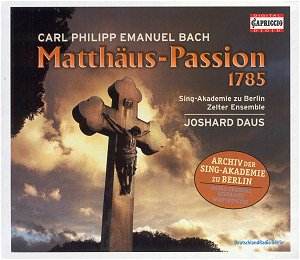In 1767 the Music Director of Hamburg,
Georg Philipp Telemann, died. As his successor, his godson Carl
Philipp Emanuel Bach, was appointed. One of his duties was to
compose and perform a setting of the Passion every year. In
Hamburg the Passions were performed in a four-year cycle, in
which the Gospels alternated, starting with St Matthew and closing
with St John. Bach asked Telemann's grandson, Georg Michael,
who had taken over his grandfather's duties for the time being,
what the circumstances of Passion performances in Hamburg were,
assuming his first duty was to compose a Passion for 1768. But
his departure from Berlin was delayed and he arrived in Hamburg
shortly before Easter 1768. Therefore his first Passion was
the St Matthew Passion of 1769.
Passions in Hamburg were considerably
shorter than elsewhere. There were two reasons for this. Firstly,
the Passion was performed during a regular service, not as part
of a special Vesper service - as in Leipzig, for instance. In
addition, many members of the congregation didn't enter church
before the sermon started. Therefore it was decided to perform
the whole Passion after the sermon, whereas originally Passions
were divided into two parts, to be performed before and after
the sermon respectively. As a result the Passions written for
Hamburg started with Jesus and his disciples going to the Mount
of Olives, and ended with the Crucifixion.
The circumstances under which Bach
had to produce the Passions were less than ideal. The Passion
had to be performed in the five main churches within a couple
of weeks, and the Music Director was also responsible for the
Passion music in the subsidiary churches. But he had no more
than eight singers and fifteen instrumentalists at his disposal.
One of the features of Bach's Passions
is the use of music by other composers. One of the sources of
Bach's borrowings was his father's St Matthew Passion. In particular
Johann Sebastian's settings of the turbae and chorales were
incorporated into Carl Philipp Emanuel's Passions. In his first
settings they are used practically unaltered, but from the second
half of the 1770s on he started to rework them, in order to
create a greater stylistic unity within his Passions. In the
St Matthew Passion of 1785 we find a number of passages which
sound very familiar to our ears - not, of course, to those of
the Hamburg congregation, which had never heard the old Bach's
Passions -, but in most cases something has changed, for instance
the harmony or the instrumentation. He took over some hymns,
but on a different text, or he put them in a different place.
Sometimes the upper voice remains unaltered, but the other parts
have been changed. In some turbae Bach uses the same rhythm
as his father, but on different music. In others he keeps the
basic structure, but changes the instrumentation.
There are also considerable differences
between the Passions of Johann Sebastian and Carl Philipp Emanuel.
First, the Passions of the latter are far less dramatic, and
much more lyrical, which is especially demonstrated in the choruses.
It is here where Carl Philipp Emanuel uses stanzas from newer
hymns. Since the chorales were sung by the congregation he could
use only those melodies and texts which were printed in the
Hamburg hymn book which was unaltered since 1700.
Another difference is the number
of arias. In this Passion there are just three: two for bass
and one for tenor, with one arioso for soprano. The texts reflect
the spirit of the Enlightenment. They are of a more reflective
and rather moralistic nature, like the aria 'O grosses Bild
des Menschenfreundes': "O great image of a friend of man,
gaining salvation for his enemies, come, from him learn about
love (...). Do not desecrate religion through impetuous forces
of revenge."
It is good to have a recording
of this Passion, which is part of the archive of the Berlin
Singakademie. The archive disappeared at the end of World War
II and thankfully was rediscovered in 1999 in Kiev. But I wish
the performance had been better. The main problem is not that
the orchestra is playing on modern instruments, although that
is disappointing. It does its best to play like period instrument
orchestras, but does so not very convincingly: even the leader,
the seasoned baroque violinist Florian Deuter, can't really
change the traditional playing style. A bigger problem is the
choir, which is far too large, lacks clarity and flexibility
and produces a sound which is too thick and massive.
The recitatives are sung in tempi
which are generally unnaturally slow. The singing of Thomas
Dewald and Daniel Jordan is too traditional and vibrato-ridden.
Jochen Kupfer is the only participant who is thoroughly convincing
in his stylish performance of the two bass arias.
This St Matthew Passion deserves
a much better performance than it is given here.
Johan van Veen

![]() Isabella Stettner, soprano;
Thomas Dewald (Evangelist), tenor; Daniel Jordan (Jesus), Jochen Kupfer,
baritone
Isabella Stettner, soprano;
Thomas Dewald (Evangelist), tenor; Daniel Jordan (Jesus), Jochen Kupfer,
baritone![]() CAPRICCIO 60.113 [55:01]
CAPRICCIO 60.113 [55:01]





